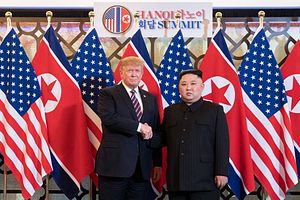A few years ago, the United States came close to nuclear war. According to Bob Woodward’s new book, “Rage,” throughout the summer of 2017 and January 2018, the Pentagon was on the lookout for a potential North Korean attack. Then Secretary of Defense James Mattis would go to the National Cathedral to pray because, “He was growing increasingly alarmed about the possibility of a war that could kill millions.”
Indeed, if war had broken out it would have killed millions in Seoul and Tokyo, at American bases in the Pacific, and in U.S. cities as far away as Washington, D.C. and New York City. Thankfully, war was averted. But this episode should serve as a warning of how easily a crisis could spin out of control.
There are two major misconceptions when it comes to North Korea that continue to haunt U.S. policymaking. First, there are some leaders who falsely believed that any war would be waged “over there” and that Americans would largely be safe.
Second, many policymakers who favor “maximum pressure” think Pyongyang can be coerced into accepting Washington’s denuclearization demands. Worse, some even believe it would be acceptable to attack North Korea to force compliance. Yet maximum pressure is not only unsuccessful — it ignores the very real possibility that maximum pressure, combined with an accidental crisis, might be seen in Pyongyang as a prelude to war just as Washington destroyed Libya’s Muammar al-Gaddafi or Iraq’s Saddam Hussein.
Over There?
According to two Gallup polls, more Americans supported military action against North Korea during the fall 2017 tensions than during the spring 2003 tensions. These views held, even though in 2017 North Korea actually had nuclear weapons and in 2003 Pyongyang was still three years away from its first nuclear test. In both surveys, Gallup asked, “If the United States does not accomplish its goals regarding North Korea with economic and diplomatic efforts, would you favor or oppose using military action against North Korea?” In September 2017, 58 percent of Americans favored military action, while 39 percent opposed it; in January 2003, 47 percent of Americans favored military action while slightly more, 48 percent, opposed it.
These surveys are bizarre and troubling since many more Americans would have died from war in 2017 than if North Korea and the United States had fought one in 2003. Nuclear war resulting from conventional conflict cannot be ruled out. Washington should see this threat and focus on both engaging and deterring Pyongyang.
Maximum Pressure
Denuclearization is a worthy, though likely impossible, goal. Kim Jong Un wants to live for a long time and keep his family in power indefinitely. He knows that policymakers in Washington tend to be hawkish and that the threat of nuclear retaliation will help keep him safe. This is why he will never give up all of his nuclear arsenal.
Moreover, maximum pressure simply does not work. Sanctions can punish through pummeling another country’s economy and their people’s livelihoods, but they rarely persuade. Moreover, in the case of a stubborn and already economically-disconnected country like North Korea, sanctions have a diminishing impact.
The other problem is that maximum pressure also means military pressure through increased threats of violence, exercises and reconnaissance flights. For example, according to “Rage,” “On September 25, the U.S. command flew a simulated air attack, sending B-1 bombers and some 20 other planes, including cyber-capable aircraft, to cross the Northern Limit Line that separated South and North Korea in the sea. The planes stopped short of entering into North Korean territorial airspace or over North Korea itself, but it was an extremely provocative action.”
As if that weren’t enough, at another point in time Woodward claims the Pentagon considered “some actual bombing action in a North Korean port to send the message” that Kim had to accept denuclearization. Thankfully no bombing was ordered and South Korean President Moon Jae-in told Washington that the simulated air attack had gone too far. Meanwhile, all of these actions were not made public and these possible flashpoints went unknown to policymakers and the American people.
Find the Off Ramp
Deterrence works but only when coupled with diplomacy to defuse crises. Maximum pressure is dangerous with a country like North Korea because there are few official contacts and ways to reduce tensions, increasing the odds of any action being seen as a provocation or the start of a war. According to “Rage,” Secretary Mattis recognized this delicate balance and feared a real conflict.
Without engagement, neither side will understand each other’s red lines and so might accidentally go too far. Thankfully, the American people realize this. According to a recent survey by the Eurasia Group Foundation, 59.4 percent of Americans say Washington should “negotiate directly with adversaries to try to avoid military confrontation.” Only 40.6 percent disagree.
In the future, the crisis of summer 2017-January 2018 should be seen as a warning of how maximum pressure, along with a false sense of safety from attack, could lead to a nuclear war. Woodward claimed in “Rage” that Kim Jong Un, upon meeting then-CIA Director Mike Pompeo for the first time, said Pyongyang had been ready and was “very close” to going to war. Thankfully, that didn’t happen.
John Dale Grover is a fellow with Defense Priorities and a Korean Studies fellow at the Center for the National Interest. His articles have appeared in The Diplomat, Fox News, Stars and Stripes, Real Clear Defense, and The Hill.

































